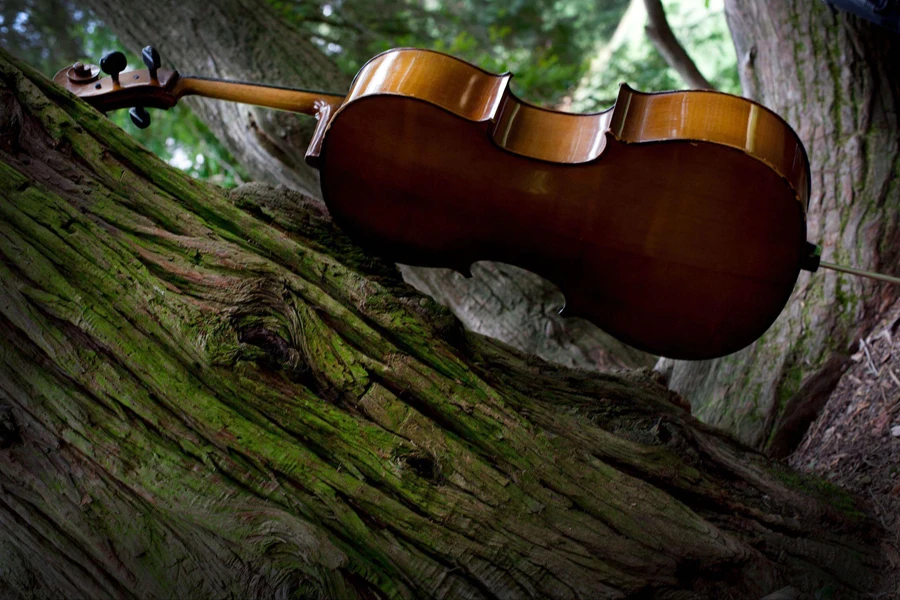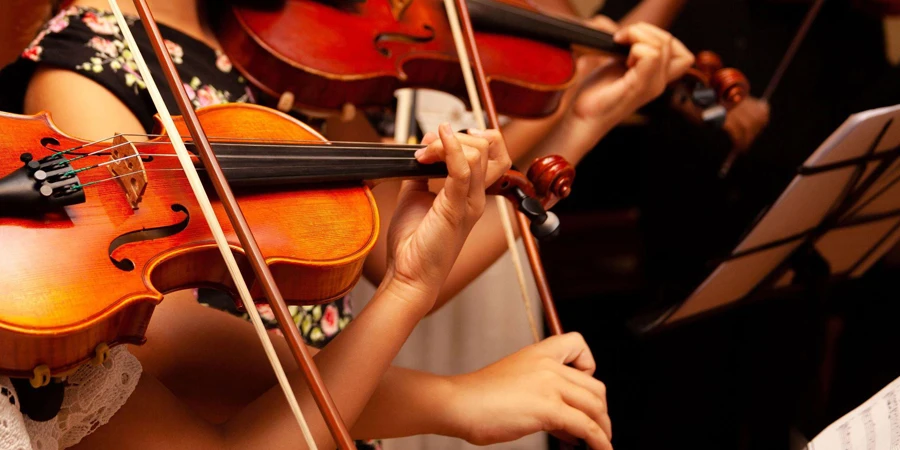Table of Contents
● Introduction
● Market Overview & Insights
● Key Considerations of Selection
● Top Picks for 2024
● Conclusion
Introduction
In the quest for musical excellence, the violin remains a timeless choice for musicians worldwide. As we navigate through 2024, the selection of the right violin is pivotal for both emerging talents and seasoned professionals. This guide is meticulously crafted to assist you in choosing a violin that resonates with your artistic aspirations, ensuring a harmonious blend of craftsmanship, playability, and tonal beauty.
Market Overview & Insights
The global violin market size was USD 340.3 million in 2022 and is projected to reach USD 416.36 million by 2031, exhibiting a compound annual growth rate (CAGR) of 2.3% during the forecast period. This growth is fueled by the increasing demand for both electric and acoustic violins, with the global market size reaching approximately USD 468.34 million by 2030. The United States, in particular, is expected to see a market volume of US$7bn by 2028, with a growth rate of 5.06% from 2024 to 2028. These figures underscore the violin’s enduring appeal and the industry’s robust health, offering a plethora of options for today’s discerning musicians.
Some of the top companies operating in the violin market include YAMAHA, FranzSandner, STENTOR, Beth Blackerby, KAPOK, GCV-Violins, JinYin Musical, Bellafina, NS Design, Barcus Berry, Hofner, Silver Creek, Wood Violins, Jonathan Cooper, Consordini, Rogue, D’Addario, Bridge, Earthenware, The Realist, Super Sensitive, and Musician’s Gear.

Key Considerations of Selection
When selecting a violin, numerous factors come into play, each contributing to the instrument’s overall quality and suitability for the musician. Here are the key considerations to guide your choice:
Craftsmanship and Materials
The creation of a violin is a blend of art and precision, where the choice and treatment of wood are paramount. Spruce, known for its strength, flexibility, and lightness, is often the preferred choice for the top of the violin, where the bridge rests, contributing to the instrument’s sound vibration quality. The ribs and back of the violin, typically made from maple, add depth and enhance the sound conduction, with maple’s beautiful grain adding to the violin’s aesthetic appeal. The purfling, a decorative inlay along the edge of the violin, is more than just ornamental; it’s crafted from three pieces of wood, including pearwood or dyed poplar, and helps prevent cracks on the top and back of the instrument.
The violin’s scroll, a distinctive and often creatively carved piece, is usually made from the same wood as the pegbox, typically maple or poplar. Tuning pegs, essential for adjusting the pitch of the strings, are crafted from durable woods like ebony, rosewood, or boxwood, capable of withstanding the tension of the strings. The neck of the violin, extending from the body and holding the fingerboard and strings, is typically made of maple, a wood strong enough to handle the tension and pressure of the strings. The bridge, a crucial component made of maple, lifts the strings from the violin’s top and plays a significant role in tone production and playability. The internal parts, like the soundpost and bass bar, though unseen, are vital for the instrument’s sound quality, with the soundpost often made from spruce and supporting the treble side of the violin.

Size and Ergonomics
| Size | Body Length (Approx.) | Typical Age | Arm Length (Approx.) |
| 4/4 (Full) | 356 mm (14 inches) | 12 years to adult | 23.5 inches and above |
| 7/8 | Slightly smaller than full size | Older children to adult | 22 to 23.5 inches |
| 3/4 | 335 mm (13.2 inches) | 9 to 11 years | 21.5 to 22 inches |
| 1/2 | 310 mm (12.2 inches) | 6 to 10 years | 20 to 22 inches |
| 1/4 | Smaller than 1/2 size | 4 to 7 years | 18.5 to 20 inches |
| 1/8 | Smaller than 1/4 size | 3 to 5 years | 16.5 to 18.5 inches |
| 1/10 | Smaller than 1/8 size | 3 to 4 years | 15 to 16.5 inches |
| 1/16 | Smaller than 1/10 size | 3 years and under | Less than 15 inches |
| 1/32 | Very small | Very young children | Very small arm length |
| 1/64 | The smallest available | Very young children | Extremely small arm length |
Notes:
- Arm Length Measurement: From the neck to the middle of the palm.
- Age Ranges: These are approximate and can vary based on the child’s size.
- Fitting: Professional fitting is recommended for the most comfortable and ergonomically correct size.
Sound Quality
Each violin sings with its own voice, and its sound quality is a blend of various factors. The tonal quality of violins can range from extremely bright, akin to a piccolo, to very mellow, resembling the sound of a French horn or cello. The choice of sound depends largely on personal taste and the intended use of the instrument. For instance, a very bright violin might seem loud and clear to the player but may not project as well in a large hall due to the abundance of overtones. Conversely, a mellow and dark sounding violin might produce an unfocused tone that sounds “muddy” a few feet away from the player.
For most students and progressing players, a mellower instrument is recommended as it’s easier to sound good, more pleasant to listen to, and more forgiving in terms of intonation and bow control. Advanced players with confident vibrato and bow control might opt for a brighter violin, which can sound great in skilled hands. It’s important to note that with excellent technique, a bright instrument can be made to sound mellow and luscious, but it’s challenging to make a mellow instrument sound bright.
Electric or Acoustic
The choice between an electric and an acoustic violin is influenced by the musician’s style and needs. Electric violins, equipped with solid bodies and piezoelectric pickups, are versatile instruments used in various music genres, including rock and jazz fusion. They offer the ability to amplify or modify the sound, making them ideal for musicians who require a wide range of sound effects or who perform in settings where amplification is necessary. Electric violins can be plugged into instrument amplifiers and speakers to produce sound, allowing for greater control over the audio output.

On the other hand, acoustic violins, with their hollow wooden bodies, provide a traditional and organic tone. They are most prominent in Western classical music, both in ensembles and as solo instruments, and are also important in many varieties of folk music. The sound of an acoustic violin is shaped by its construction, including the wood it is made from, the thickness of the wood, and the craftsmanship of the luthier. The natural acoustics of an acoustic violin offer a rich, resonant sound that is highly valued in classical and traditional music settings.
Top Picks for 2024
The market offers a variety of violins that stand out in 2024. Here are some top picks, each with unique attributes catering to different preferences:
Best Violins for Beginners
- Designed specifically for the youngest of students, the Fiddlerman OB1 Violin offers sizes 1/4 and 1/8, catering to early learners. It stands out for its exceptional craftsmanship and design, akin to the Fiddlerman Apprentice. A significant advantage of the OB1 is its lifetime structural warranty, which adds considerable value to this investment. While its sound quality may not entirely match that of the Apprentice model, it still provides a satisfactory tonal range for beginners. Additionally, its higher resale value makes it an attractive option for those planning future upgrades.
- The Cecilio CVN-300 stands out as an excellent value violin, offering features typically found in more expensive models. It’s well-constructed and designed to cater to the needs of beginner violinists. The sound quality is expected to be suitable for beginners, making it an ideal choice for those learning the basics of violin playing. The CVN-300 is known for providing more than its price suggests, making it a smart choice for budget-conscious learners seeking quality.
Best Violins for Professionals
- The Ming Jiang Zhu 909 Violin is a remarkable instrument that stands out for its ability to produce a wide range of textures in its sound. Crafted by a world-class luthier, this violin is a testament to the art of violin making. Its sound is characterized by a certain depth and complexity, making it a favorite among professional musicians. The violin’s construction is a blend of traditional craftsmanship and modern techniques, ensuring both aesthetic beauty and exceptional sound quality. The Ming Jiang Zhu 909 is not just an instrument but a piece of art, offering a rich and nuanced tonal palette that can enhance any performance.
- The D Z Strad Violin Model 800 is a testament to the exquisite craftsmanship of violin making. Made with beautifully aged wood from the Italian Alps, this violin is known for its exceptional sound quality and fine varnish that highlights the natural grain of the wood. The aged wood contributes to the violin’s rich and mature sound, making it a preferred choice for professional musicians. The fine varnish not only protects the wood but also enhances the violin’s overall tonal qualities. The D Z Strad Model 800 is a perfect blend of aesthetic beauty and superior sound production, making it a highly sought-after instrument among professional violinists.

Conclusion
The pursuit of the perfect violin is a journey as personal and unique as the musicians themselves. In 2024, the market abounds with options that cater to every nuance of preference and purpose. By considering the key factors outlined in this guide, you can make an informed decision that harmonizes with your musical ambitions, ensuring that your chosen violin not only meets but exceeds expectations.




